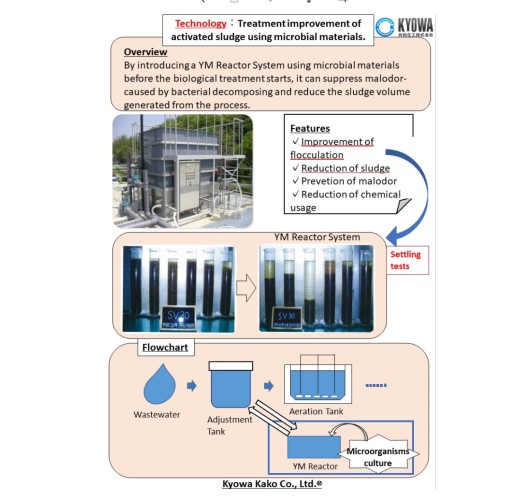Treatment Improvement of Activated Sludge Using Microbial Materials
Technology / Service Summary
By introducing a YM Reactor System using microbial materials before the biological treatment starts, it can suppress malodor-causing bacteria of decomposing process and reducing the sludge volume from the treatment process.
Purpose
Control of the malodor-causing substances in sewage or wastewater before/during the biological treatment (which is a problem in sewage/wastewater treatment plants). In addition, improvement of the sedimentation of activated sludge, which leads to treatment stabilization and reduction of excess sludge.
Feature
Due to introduction of the YM Reactor System, in which activates the action of microorganisms on wastewater flocculation and cohesion properties leading into excellent sedimentation and improvement of supernatant liquid, resulting in a stabilization and reduction of activated sludge generation in the system. In addition, it is expected to improve the Plant treatment capacity by improving the decomposition of fats and oils, organic substances and preventing the cause of malodor. As a final result, it is possible to stabilize the treatment, reduce the amount of sludge generation in the system, and reduce the cost of flocculants.
Effect
・Stabilization of sewage/wastewater treatment process.
・Reduction of sludge treatment cost by reducing generation of sludge.
・Suppression of malodor by introducing the system.
・Cost reduction by reducing the amount of flocculant.
Controlled Substance
Applicable Regions / Countries
- Japan
- Southeast Asia
- Central/South Asia
- China/ East Asia
- Middle East
- Africa
- Oceania
- Europe
- Central/South America
- ASEAN countries
Indonesia,Cambodia,Singapore,Thailand,Philippines,Brunei Darussalam,Viet Nam,Malaysia,Myanmar,Lao PDR
Accomplishments
13 Installations of YM Reactor System throughout Japan.
Related SDGs Goals
- 6. Clean Water and Sanitation
- 7. Affordable and Clean Energy
- 9. Industry, Innovation and Infrastructure
- 11. Sustainable Cities and Communities
- 12. Responsible Consumption and Production
- 13. Climate Action
- 14. Life Below Water
- 15. Life on Land



